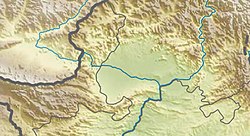
Back धर्मराजिक HI Stupa Dharmarajika ID धर्मराजिका स्तूप MR ဓမ္မရာဇိကစေတီတော် MY دھرماراجیکا سٹوپا PNB ڌرما راجيڪا اسٽوپا SD Stupa Dharmarajika SL தர்மராஜிக தூபி Tamil ธรรมราชิกสถูป (ตักศิลา) Thai دھرما راجیکا اسٹوپا UR
 The Dharmarajika Stupa, Taxila | |
| Location | Taxila Cantonment, Punjab |
|---|---|
| Coordinates | 33°44′N 72°47′E / 33.73°N 72.78°E |
| Type | Monastery |
| Part of | Taxila Ruins |
| History | |
| Founded | 3rd century BCE |
| Site notes | |
| Archaeologists | Sir John Marshall |
| Official name | Taxila |
| Criteria | iii, iv |
| Designated | 1980 |
| Reference no. | 139 |
The Dharmarajika Stupa (Punjabi, Urdu: دھرم راجک اسٹوپا), also referred to as the Great Stupa of Taxila, is a Buddhist stupa near Taxila, Pakistan. It was built over the relics of the Buddha by Ashoka, the Emperor of Magadha, in the 3rd century BCE.[1][2][3][4][5] The stupa, along with the large monastic complex that later developed around it, forms part of the Ruins of Taxila - which were inscribed as a UNESCO World Heritage Site in 1980.[6]
- ^ Scarre, Geoffrey; Coningham, Robin (2013). Appropriating the Past: Philosophical Perspectives on the Practice of Archaeology. Cambridge University Press. ISBN 9780521196062. Retrieved 22 June 2017.
- ^ Cite error: The named reference
ISBN_9781438109961was invoked but never defined (see the help page). - ^ Le, Huu Phuoc (2010). Buddhist Architecture. Grafikol. p. 54. ISBN 978-0-9844043-0-8.
- ^ Fogelin, Lars (2015). An Archaeological History of Indian Buddhism. Oxford University Press. p. 115. ISBN 978-0-19-994823-9.
- ^ Neelis, Jason (19 November 2010). Early Buddhist Transmission and Trade Networks: Mobility and Exchange Within and Beyond the Northwestern Borderlands of South Asia. BRILL. p. 203. ISBN 978-90-04-18159-5.
- ^ "Taxila". UNESCO. Retrieved 23 June 2017.

